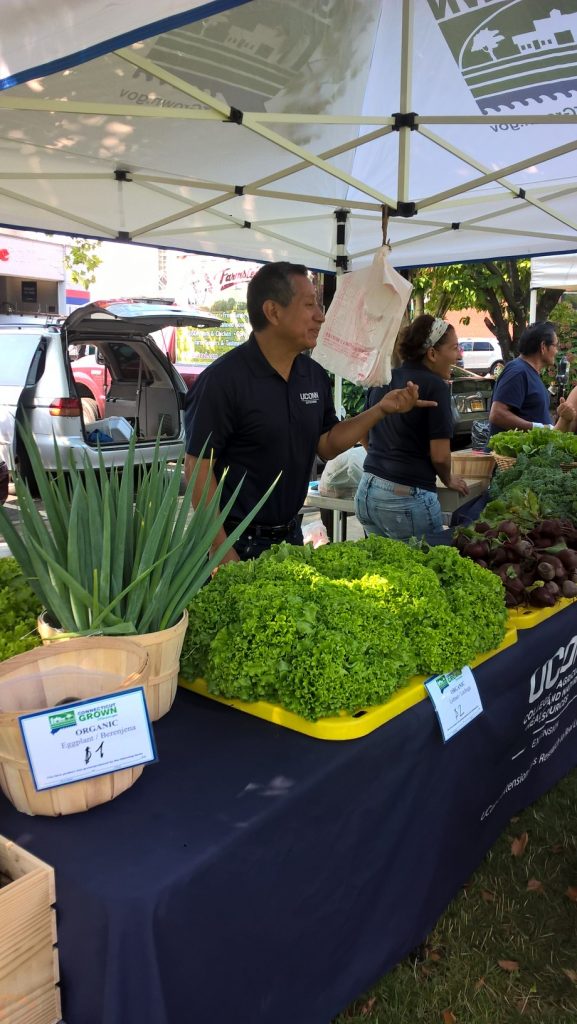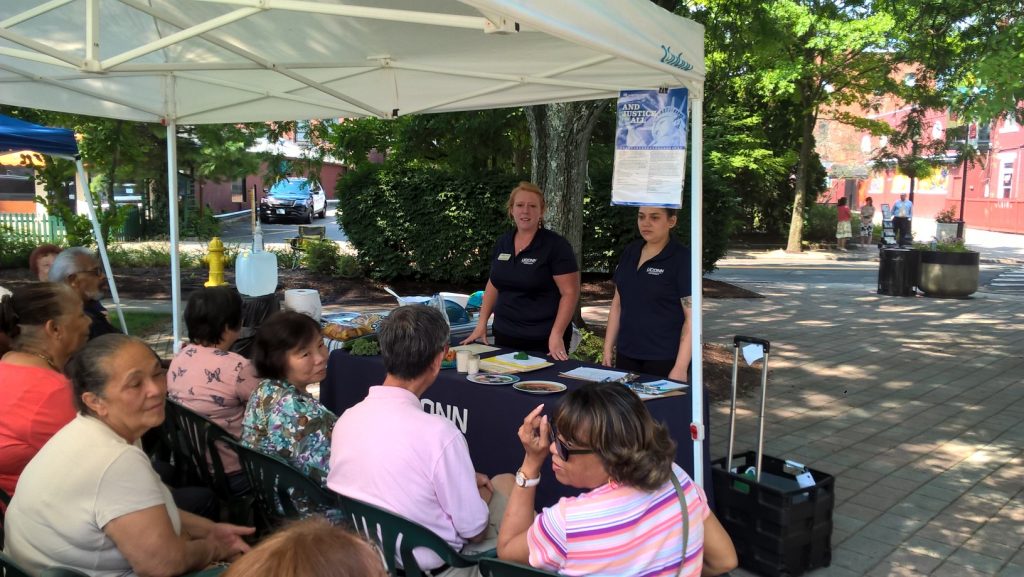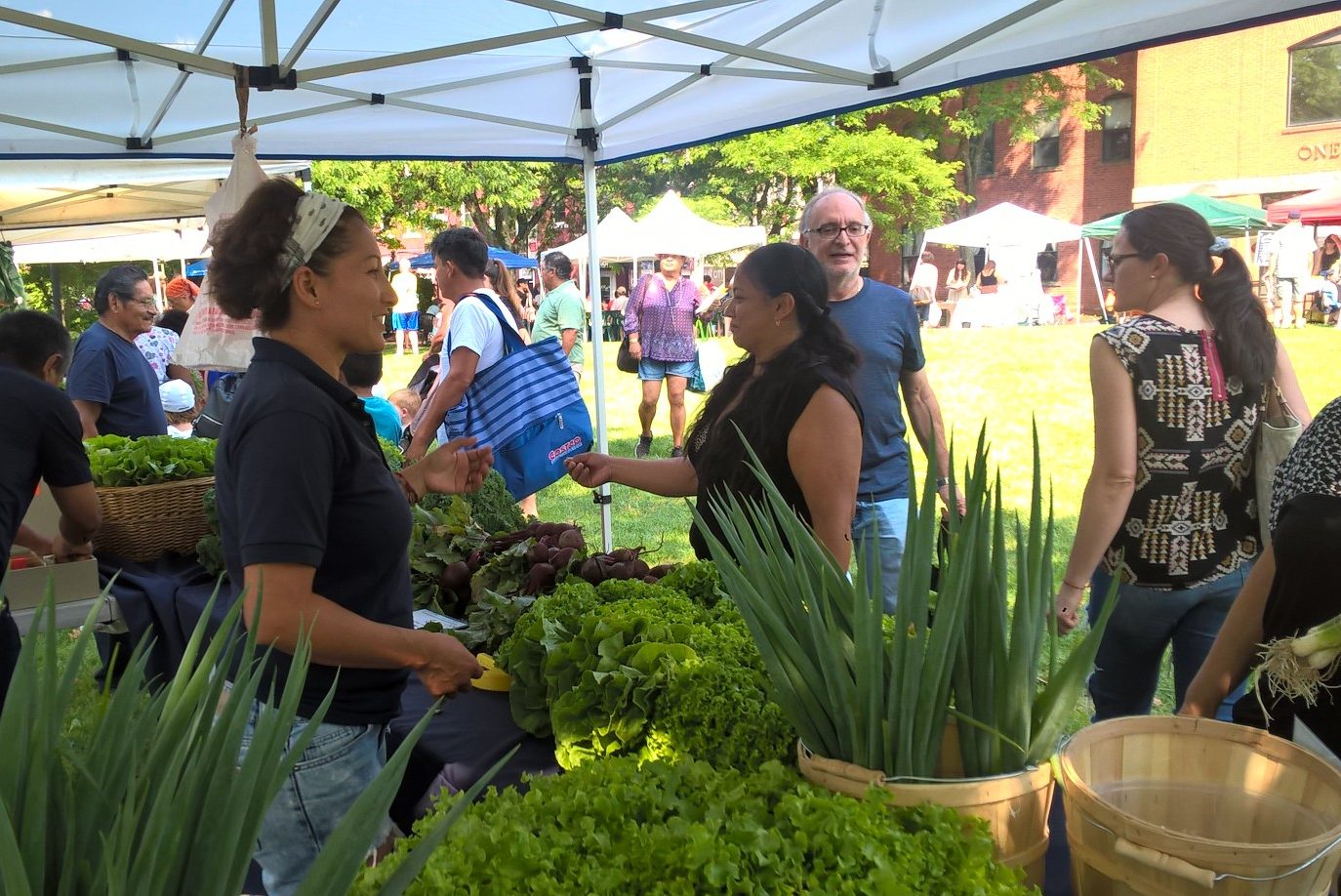It’s a warm summer Saturday, and Partha Loor has come to the Danbury Farmer’s Market to sell the produce she and the other members of UConn Extension’s urban agriculture program harvested the day before. Customers cluster around the tables bearing mounds of eggplants, beets, cabbages, lettuce, cilantro, zucchini, and onions as Loor and her daughter, Amira, bag vegetables and take payments.
The urban agriculture program was started in 2014 by German Cutz, associate extension educator for sustainable families and communities. A group of Hispanic men and women from Danbury wanted to learn to grow the vegetables they missed from their homeland, and he’d promised to look for a program of study in Spanish. Serendipitously, about the same time a farmer in nearby New Milford called Cutz’s office at the Fairfield County Extension Center in Bethel to offer a section of his farmland for UConn Extension’s use in teaching people to farm.

After a nationwide search failed to turn up a suitable Spanish language curriculum on growing vegetables, Cutz embarked on developing his own, based on the nationally approved Master Gardener program. He visited with the New Milford farmer, Carl Dunham of Candlelight Farms, who was enthusiastic about Cutz’s proposed project. With the availability of farmland, Cutz’s vision had evolved from teaching vegetable gardening to a few people to the establishment of a market farming operation. The urban agriculture program was born.
“Urban agriculture is focused on producing food with the intention of selling it,” Cutz explains. “It has three components: producing, processing, and distributing. If you meet those three criteria, you’re doing urban agriculture.” His hope was that participants in the new program would see not only the prospect of growing their own vegetables, but a business opportunity as well.
The program has three integrated parts: classroom modules in soils, botany, entomology, integrated pest management, and vegetable production; hands-on production using organic methods; and entrepreneurship. Substantial commitment of time and energy is required of participants, most of whom have jobs and families and little or no previous agricultural experience. Classes run from November to November, production from April to October, and selling is from June through October at local farmers markets. All three components are essential to the participants’ –and program’s—success. In addition to passing the five classroom modules with a grade of 70 percent or higher, participants must perform 80 hours of work at the farm and 40 hours of sales at the farmer’s market.
At the market, business is brisk. In this, the entrepreneurship component, the new farmers see firsthand the demand for their produce. The first item to disappear is the cabbage; a short time later the last eggplants go, then the cilantro. Loor says cilantro is their most popular product. It’s special; they’ve learned that the Danbury market’s largely Hispanic clientele likes it grown to full maturity, while other groups prefer the taste of younger cilantro. Seeing how well the cilantro sold, the group has started offering it in bundles with other products: tomatoes and onions to make salsa, for example. Cutz says the participants continually assess customers’ preferences, choosing crops and planning their growing season accordingly. They practice crop rotation, intercropping, and succession cropping to keep supply steady through the season.
It is well known that low-income urban areas are often food deserts, lacking supermarkets or other retailers that offer affordable nutritious food. Residents often have to rely on convenience stores carrying mostly expensive, high-calorie, low-nutrient packaged foods laden with salt, sugar, and preservatives, bringing both economic and health consequences. The urban agriculture program’s new farmers are helping to improve access to fresh food for residents of Connecticut’s low-income urban areas. During the 2018 growing season, the Danbury group produced 15,000 pounds of vegetables on its 1.5-acre plot at Candlelight Farms.
The Danbury Farmer’s Market places a heavy emphasis on nutrition. On the other side of the green, two of Cutz’s co-workers, Assistant Extension Educator Heather Peracchio, a registered dietitian nutritionist, and Program Aide Julianne Restrepo Marin are conducting their second nutrition class of the day. After reviewing USDA’s Choose My Plate dietary guidelines, they’re preparing “market salsa,” with ingredients for sale that day. Peracchio and market director Peggy Zamore have worked with a private donor to underwrite $15 market vouchers for those who attend the class. The tent is packed with market goers listening intently in preparation for cashing in their vouchers on Connecticut’s summer bounty.
While the urban agriculture program was originally developed to serve lower-income urban residents, others hearing of the program wanted to participate. In seeking to address the scarcity of fresh food, Cutz felt he couldn’t afford to turn anyone away. His current Danbury cohort is a mix of English and Spanish speakers, some professionals, others who work in construction or service industries, and others who are un- or underemployed and living in poverty. Cutz now teaches the classes and hands-on field work in English and Spanish simultaneously. All text materials are in both languages, English and Spanish pages and slides are used side by side, and his lectures in the classroom and in the field are done in both languages as well. In fact, the Danbury program is now listed as an ESL class.
When word of the urban ag program began to get out, Cutz heard from groups in other cities eager to organize similar projects. He now conducts a program in Bridgeport in partnership with the Green Village Initiative, where growing space was available but there was no one to teach aspiring farmers, and a new program may start this fall in Hartford, in partnership with KNOX.

The income from produce sales goes back into the program, for seed and inputs, as well as small stipends for the participants to help defray the cost of their participation. Cutz works in partnership with other UConn Extension educators and faculty to obtain grants that are the primary support for the program.
At the end of the farmer’s market, all that’s left are a few large zucchini, which will be distributed among the program participants. When larger amounts remain, the produce is donated to food pantries or shelters.
The ultimate goal is for graduates of the program to establish independent growing operations. Three graduates of the Bridgeport program have done just that, and, in what Cutz calls an unintended outcome, three of the Danbury graduates have been hired by area farmers. Says Cutz, “More than 99 percent of urban residents don’t produce their own food. With this program, we’re working to change that.”
This project was sponsored by the USDA-NIFA Beginning Farmer and Rancher Development Program Award #2016-70017-25416 and Farm Credit East # 6208260



